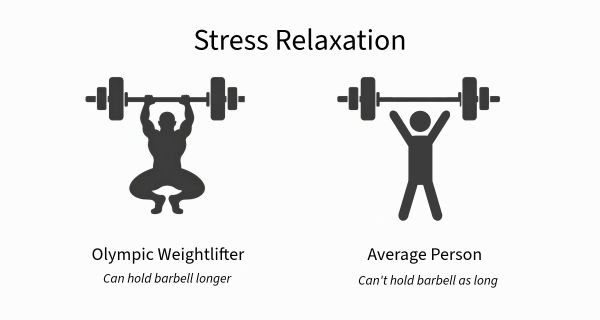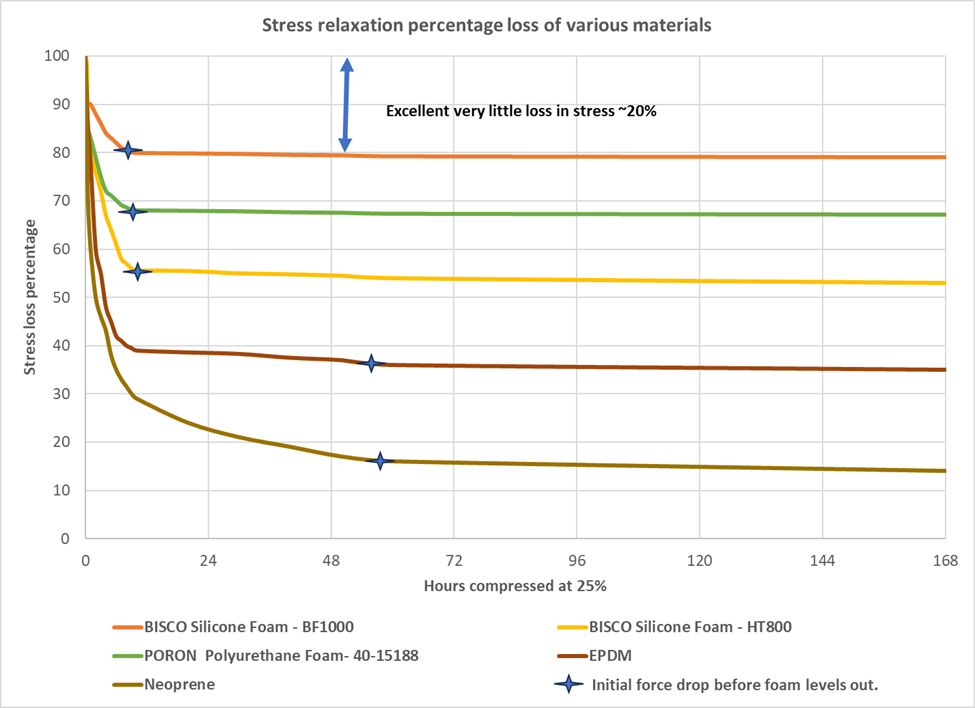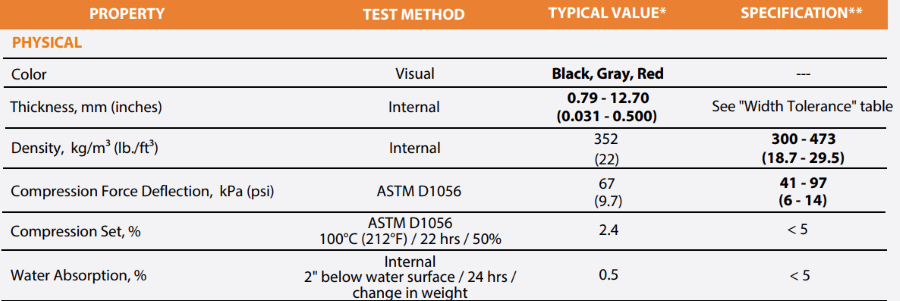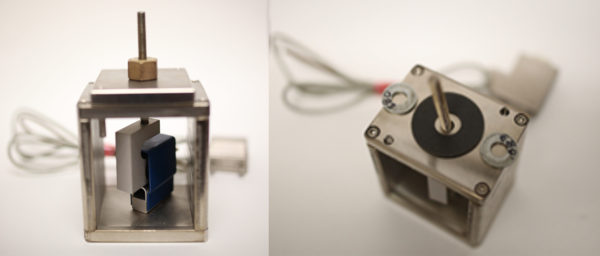
Published
by Rogers Corporation
Elastomeric Material Solutions
Designing a seal in an application requires a thorough understanding of several properties to facilitate optimal performance and longevity. Among these properties, stress relaxation plays a critical role in analyzing the behavior of elastomeric materials under constant strain.
Let's dive into an overview of stress relaxation for elastomeric materials and what you need to know to make informed design decisions.
Key Material Properties for Sealing Applications
When designing a new sealing application, consider these three material properties:
- Compression deflection – material firmness
- Compression set – material memory
- Stress relaxation – constant force over a period
Each of these properties impact the performance and durability of elastomeric seals. Click on the hyperlinks above to explore the topics more in-depth.
Does Stress Relaxation Come Up Often in Application Design Discussions?
Stress relaxation is becoming a more important consideration as a material's ability to maintain consistent pushback force over time is crucial for device performance.
When discussing material choices, design engineers typically focus on finding a material with the right compression force deflection. Engineers often set out to make a specific seal and need the material to be the right firmness during the manufacturing process of the device or enclosure.
However, while compression set values are often prioritized, stress relaxation is frequently overlooked- yet it is essential for the long-term reliability of elastomeric seals.
What is Stress Relaxation?
Stress relaxation is the effect in which an elastomer loses some of the constant force (sometimes called pushback force) between two surfaces over a long period of time.
In other words, stress relaxation describes how a material gradually reduces the pushback force exerted against it as it remains compressed for a prolonged period.
Why Does Stress Relaxation Occur?
The stress relaxation phenomenon occurs because the molecules of the material can slip against each other, reducing the stress on the material.
All elastomers will show some relaxation (lose some pushback force) over time as they try to move toward their original state. The difference is that some materials lose this pushback force in a short time while others can maintain the force, though it will be lower than at the time the gasket was first compressed.
Real-World Examples: How Stress Relaxation Works
Weightlifter
Imagine an Olympic weightlifter holding a barbell above their head. Initially, the weightlifter can maintain the position, but over time, their muscles fatigue, and they can’t hold the same force. Now picture an average person attempting the same feat. They would fatigue much faster than the Olympic weightlifter.
This scenario is similar to what happens with elastomeric seals in application. The foam or sponge material initially resists compression but gradually loses its pushback force. How much the pushback force decreases (or the extent of the loss) depends on the material formulation and cellular structure.
Stress relaxation provides valuable insights into how materials perform under constant compression. Over time, all materials will gradually lose their pushback force due to internal molecular restructuring.
Stress Ball and Sand Ball
Another way to think about stress relaxation is by comparing a stress ball to a sand ball. Think of the stress ball as a gasket. When compressed, it pushes back with a force that creates a reliable seal. As soon as you release it, the ball returns to its original shape, maintaining its pushback force over time. This is how high-performance materials like BISCO® silicones and PORON® polyurethanes behave, ensuring long-lasting reliability.
Now, consider the sand ball. When you squeeze it, it compresses, but upon release, it stays deformed, offering no pushback force. This represents low-performance materials that lose their ability to maintain a seal due to stress relaxation. Over time, such materials can lead to leaks, failed seals, and costly repairs.
Why Does Stress Relaxation Matter in Sealing Applications?
Stress relaxation is a critical indicator in determining how well a material can maintain an effective seal. It is especially important when an application needs a seal to hold up for prolonged periods, typically years.
Did you know that many low-cost elastomers will lose more than 50% of their original force in less than one hour?
This means low-cost elastomers may not maintain the pushback force they were designed for, which can pose a significant risk to your project—especially if this factor isn’t fully considered during the design phase.
Rogers offers a broad portfolio of high-performance materials, including BISCO silicones and PORON polyurethanes, that can hold up (maintain their pushback force) for years with minimal loss to the initial compression force.
The stress relaxation graph below showcases the percentage loss of BISCO® BF-1000 and HT-800 compared to other industry elastomers, such as EPDM and Neoprene.
As you can see, our silicone and polyurethane materials have a low percentage loss in comparison to other types of elastomers.
By choosing materials like BISCO® and PORON®, you ensure minimal stress relaxation and a consistently tight seal, even under prolonged compression.
Is Lower Stress Relaxation Value Better?
For cellular materials, yes. The lower the measured percentage (%) stress relaxation, the better the material will seal long-term in an application. Stress relaxation is typically expressed as a percentage of loss from the original compression deflection values.
For example, let's look at the BISCO HT-800 silicone foam Technical Data Sheet (TDS).
We see that BISCO HT-800 has an original compression force deflection of 9.7 psi. If we keep the material in the tester for a longer period, it will lose about 20% of the original force, or in other terms, the actual long-term firmness value is 8 psi (which for a seal is very little loss of force).
What is Considered a "Good" Versus "Excellent" Stress Relaxation Value?
It all depends on your application. Here is a table to use as a general guideline:
| Stress Relaxation % loss | Rating | Comments |
|---|---|---|
| < 25% | Excellent | Critical applications where failure is not an option. |
| 25% to 50% | Good | Acceptable in most applications |
| > 50% | Poor | Significant loss of force, may not be reliable. |
BISCO silicones and PORON polyurethanes typically have a stress relaxation in the range of excellent or good, depending on the material formulation.
How is Stress Relaxation Measured?
Stress relaxation is measured using specialized equipment that compresses a material sample and measures the loss of force over time.
The measurement device consists of a stainless-steel base and top plate, a load cell, and a data logger. See the image below for what the device looks like.
A threaded rod passing through the center is used to compress the 2 square inch area sample by way of the top plate to distribute the load over the sample. The load on the threaded rod is transmitted through the test cell frame to a load cell. In this way, a measure of the compressive force on the sample at a constant gap (strain) can be obtained. This setup allows for precise monitoring of how much force the material retains over time.
Standard Stress Relaxation Test Method
- References: ISO 3384
- Purpose: This test evaluates compressive force retention over time provided as a percentage of the initial compression force value (@ 25% compression).
- Conditions: 73°F (23°C), 50% Relative Humidity, 25% compression
- Test duration: 24 hours to 20,000 hours
- Specialty testing: Available upon request for elevated temperatures or varying compression levels
Does Temperature Matter in Stress Relaxation?
Testing is normally completed at 23°C (72°F), but if testing is done at higher temperatures, the stress relaxation percent loss for an elastomer will become greater. If designing for a higher temperature application, a BISCO silicone foam elastomer should be selected.
Is Stress Relaxation Different Than Creep? What's the Difference Between Stress Relaxation and Creep?
Yes. While both phenomena involve material deformation, the key differences are:
- Creep refers to the gradual increase in plastic strain under a constant load. This is a significant concern in components such as plastic housings or snap-fit parts.
- Stress Relaxation involves the gradual decrease in force when a material is held at a constant deformation or strain. This phenomenon is critical in the design of elastomeric seals.
Thus, stress relaxation should be the key consideration in your elastomeric seals.
Key Points
- Stress relaxation is critical for the long-term reliability of seals and gaskets.
- Low stress relaxation values ensure consistent performance and reduce failure risks.
- High-performance materials like BISCO silicones and PORON polyurethanes are designed to minimize stress relaxation.
- If you are unsure what Rogers Corporation material you need for your application, our Technical Service and Development Team is here to help! Get started by connecting with a Rogers Sales Engineer.
Related Content
- Everything You Need to Know About Compression Set for Elastomeric Foam Materials
- The Ultimate Guide to Compression Force Deflection + Free Tool
- Top 7 Unique Silicone Advantages You Can't Ignore
Published on Jan 31, 2025



